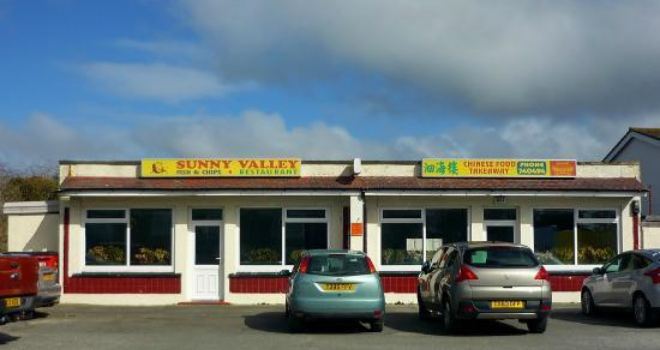Sunny Valley
No comments yet

Currently closed|Open at 16:00 today
+44 1407 740494
What travelers say:

In the UK, homes with "grave views" are ubiquitous. In the evenings, it's common to see children playing or lying near headstones. The close proximity, even separation, of cemeteries, residential areas, and schools is essentially the product of historical and cultural ideologies, reflecting the locals' unique understanding of life, death, and space.
Today, I dined at a nearby restaurant called The Bull Hotel. Afterward, I took a photo in the garden of the small but historic church across the street. Tombstones line the front and back of the church. Residents surrounded the area, and across the street was this famous local hotel. Those staying on the second floor (the first floor, for British people) had a view from their windows of this cemetery. When in Rome, do as the Romans do, so it's not surprising.
Why live so close?
- A continuation of historical inertia: In the Middle Ages, churches were the core of villages and towns. Cemeteries were often built around them (known as "churchyards"), and residential buildings naturally clustered around them—after all, religious activities were a crucial part of life. As cities expanded, cemeteries in older urban areas were not demolished, allowing new buildings to grow around them, creating the current "intertwined" landscape.
- A realistic choice of land resources: British towns have a long history, and land is scarce in core areas, making it difficult to dedicate separate suburban areas to cemeteries. Preserving existing cemeteries saves space and avoids the controversy of relocating historical relics.
How do British people view this "neighborly relationship"?
In Christian culture, cemeteries are "transitional spaces to eternal life" rather than symbols of fear. For locals, cemeteries are often tied to community memories—they may be the burial grounds of ancestors, historical figures, or even relatives of famous writers (such as Charles Dickens' relatives at London's Highgate Cemetery). This sense of familiarity alleviates the discomfort of distance.
- A daily routine of interaction: Many cemeteries are maintained like parks, with neat lawns and lush trees. Residents stroll here, walk their dogs, and even park their strollers next to the tombstones to bask in the sun. For them, cemeteries are "quiet public spaces" rather than taboo places to be avoided. This "close proximity" is actually a living cultural fossil: the tombstones in the old cemetery and the church record the community's demographic changes and historical events (such as mass burials during the plague), while the surrounding residences continue to evoke the spirit of life. The spatial interweaving of life and death imbues history with a deeper warmth—much like the college graveyards of Oxford and Cambridge, situated just steps from student dormitories, creating a unique cultural landscape.
In short, this is a lifestyle shaped by history, culture, and reality, underlying a respect for tradition and a peaceful attitude toward the coexistence of life and death.
More
Reviews of Sunny Valley
Some reviews may have been translated by Google Translate
0/5
All (1)
Latest
In the UK, homes with "grave views" are ubiquitous. In the evenings, it's common to see children playing or lying near headstones. The close proximity, even separation, of cemeteries, residential areas, and schools is essentially the product of historical and cultural ideologies, reflecting the locals' unique understanding of life, death, and space. Today, I dined at a nearby restaurant called The Bull Hotel. Afterward, I took a photo in the garden of the small but historic church across the street. Tombstones line the front and back of the church. Residents surrounded the area, and across the street was this famous local hotel. Those staying on the second floor (the first floor, for British people) had a view from their windows of this cemetery. When in Rome, do as the Romans do, so it's not surprising. Why live so close? - A continuation of historical inertia: In the Middle Ages, churches were the core of villages and towns. Cemeteries were often built around them (known as "churchyards"), and residential buildings naturally clustered around them—after all, religious activities were a crucial part of life. As cities expanded, cemeteries in older urban areas were not demolished, allowing new buildings to grow around them, creating the current "intertwined" landscape. - A realistic choice of land resources: British towns have a long history, and land is scarce in core areas, making it difficult to dedicate separate suburban areas to cemeteries. Preserving existing cemeteries saves space and avoids the controversy of relocating historical relics. How do British people view this "neighborly relationship"? In Christian culture, cemeteries are "transitional spaces to eternal life" rather than symbols of fear. For locals, cemeteries are often tied to community memories—they may be the burial grounds of ancestors, historical figures, or even relatives of famous writers (such as Charles Dickens' relatives at London's Highgate Cemetery). This sense of familiarity alleviates the discomfort of distance. - A daily routine of interaction: Many cemeteries are maintained like parks, with neat lawns and lush trees. Residents stroll here, walk their dogs, and even park their strollers next to the tombstones to bask in the sun. For them, cemeteries are "quiet public spaces" rather than taboo places to be avoided. This "close proximity" is actually a living cultural fossil: the tombstones in the old cemetery and the church record the community's demographic changes and historical events (such as mass burials during the plague), while the surrounding residences continue to evoke the spirit of life. The spatial interweaving of life and death imbues history with a deeper warmth—much like the college graveyards of Oxford and Cambridge, situated just steps from student dormitories, creating a unique cultural landscape. In short, this is a lifestyle shaped by history, culture, and reality, underlying a respect for tradition and a peaceful attitude toward the coexistence of life and death.